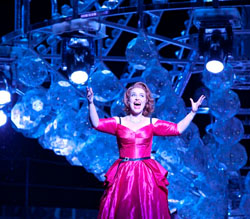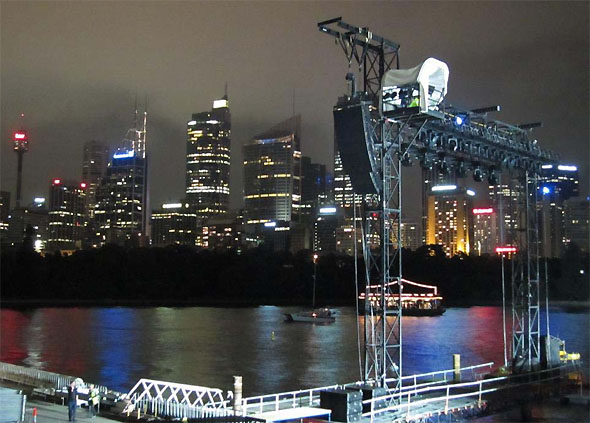When Opera Australia’s artistic director Lyndon Terracini announced that the staging of an open-air opera on Sydney Harbor, there was much skepticism from opera buffs who anticipated a production disaster.
The event presented significant technical and logistical challenges—in particular the sound quality of an operatic performance that utilized radio microphones and amplification.
However, this open-air production of Verdi’s La Traviata has opened to much acclaim by critics and while Brian Thomson’s open, sloping, diamond-shaped stage with its scene-stealing 9m x 9m crystal chandelier has grabbed initial attention, the sound quality has been praised.
Sound designer Tony David Cray, along with the team from audio provider Norwest Productions, has pulled off a coup with well-balanced sound engineering. The result is a soundscape that is an expertly mixed blend of instruments and voice with microphones picking up the full color of the score from the orchestra and revealing extra detail in the vocals.
The main PA is headed by Adamson line arrays, consisting of six Y18 and four Y10 boxes flown either side of the stage, with directional cardioid subwoofers positioned on a deck to deliver the low end. As the PA towers are 60 meters (about 180 feet) apart, a stack of three Y18 boxes are positioned at each side of the stage for additional fill.
Infill for the middle front is delivered by a pair of Y10 boxes, in a left/right arrangement in front of the stage with a pair of subwoofers positioned in front of the sea wall, and time delayed.
Cray utilized a 96-channel Avid D-Show console using a variety of inbuilt plug-ins plus additional reverbs and effects taking place outboard on a MacPro and a TC System6000 reverb unit. To assist in the limited rehearsal period, a 96-channel Pyramix multitrack record system was used so that virtual sound checks could take place without the talent being present, and this also helped with scene changes, which were in excess of 165.
Norwest spent three days testing, commissioning, equalizing and time aligning the system with a combination of Rational Acoustics Smaart 7, recorded music and a few keen ears.
Monitor engineer John Watterson, who mixed on a Digico D5T audio console probably had the hardest job of the event with 16 individual in-ear monitor mixes, six monitor loudspeaker mixes and 16 sub group mixes for the orchestra.
As well as the technical side of the job, he also had much human interaction as the majority of the performers had never used in ear monitors before. Watterson spent a lot of time getting the confidence of the cast to make them all happy.
Several weeks of rehearsals allowed the performer’s familiarity with in-ear monitors, the twelve principals have custom moulds by Ear Monitors Australia and the forty chorus-members rely on Shure SE115 earphones.
DPA 4060 omni directional head worn microphones were the microphone of choice due to their outstanding performance in windy conditions. The two microphones on each principal performer are split into a Smaart 7 sound system measurement system, so that Norwest can check that each of the two DPA microphones is performing to specification prior to each performance.
Norwest’s radio-supremo Steve Caldwell monitored and measured the frequency spectrum, with more 60 RF channels in use, consisting of 45 channels of Shure UR series radio mic in use spread across two adjoining bands. Added to that are 16 transmit channels of Sennheiser IEM furnishing 52 receive packs.
All radio microphone receivers are fed from a single pair of newly released high-performance tapered helical antennas from RFVenue, and IEM transmitters are fed through two custom weatherproof stainless log-periodic antennas.
Both antenna systems have been designed to withstand the salt water, and outdoor weather conditions. The system is monitored closely during all performances due to the somewhat hostile RF environment in this area.
“Working with Norwest has been an absolute treat, they have been awesome,” comments Cray. “They were chosen for this project because of their event experience and we knew that the project would present challenges that are quite different to normal theatre work. We were correct in making that choice as everything has been fantastic.”
What the critics said:
“The vocal lines rang forth with clarity and definition.”—The Australian
“The balance between orchestra and voices was superb and the singers sounded natural and marvellous, from Jonathan Summers’ glorious baritone, to the increasingly rich Matthews soprano, or Gianluca Terranova’s charming tenor. Sound designer and audio engineer Tony David Cray should have been on stage for the curtain calls: he did a brilliant job.”—Stage Noise
“Many were in tears and the audience was intimately bound up with her every emotion, from light hearted happiness, to fury to tremulous despair, through the true quality of the sound design. In the overall scheme of things, it was possibly the most significant technical achievement and brilliantly served both music and performers.”—Stage Noise
“The sound quality is surprisingly good, mixed as it is with the occasional hoot of a ferry and the lapping of the water.”—Sydney Morning Herald





















